当前位置:网站首页>In depth understanding of USB communication protocol
In depth understanding of USB communication protocol
2022-07-07 17:49:00 【A mouthful of Linux】
0. Basic concepts
One 【 transmission 】( control 、 Batch 、 interrupt 、 Isochronous ): By multiple 【 Business 】 form ;
One 【 Business 】(IN、OUT、SETUP): By one or more 【Packet】 form .
USB The data is in 【 Host software 】 And 【USB Device specific endpoint 】 Transmitted between .【 Host software 】 And 【USB Device specific endpoint 】 The relationship between them is called 【pipes】. One USB Equipment can have multiple pipes (pipes).
1. package (Packet)
package (Packet) yes USB The basic unit of information transmission in a system , All data is packaged and transferred on the bus . The data is in USB Transmission on the bus is in packets , Packets can only be transmitted within frames . High speed USB The frame period of the bus is 125us, Full speed and low speed USB The frame period of the bus is 1ms. The frame starts with a specific packet (SOF package ) Express , End of frame EOF.EOF It's not a bag , It is a level state ,EOF Data transmission is not allowed during .
Be careful : Although high speed USB Bus and full speed / low speed USB The frame period of the bus is different , however SOF The increase rate of frame number in the package is the same , Because on the highway USB In the system ,SOF The frame number in the packet is actually the high of the counter 11 position , The lowest three digits are not used as the microframe number , Therefore, the increase period of its frame number is 1mS
- USB What is the situation on the bus ?

Bag is USB The smallest unit of data transmission on the bus , Cannot be interrupted or disturbed , Otherwise, it will lead to mistakes . Several packets form a transaction transmission , A transaction transmission cannot be interrupted , Several packets belonging to a transaction transmission must be continuous , It cannot be completed across frames . A transfer consists of one to many transaction transfers , It can be completed across frames .
USB The package consists of five parts , Synchronization field (SYNC)、 Package identifier field (PID)、 Data field 、 Cyclic redundancy check fields (CRC) And package end fields (EOP), The basic format of the package is shown in the following figure :
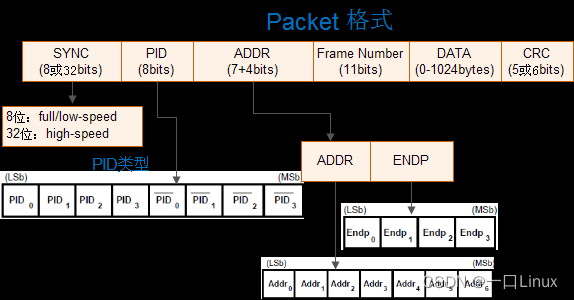
1.1 PID type ( Package type )
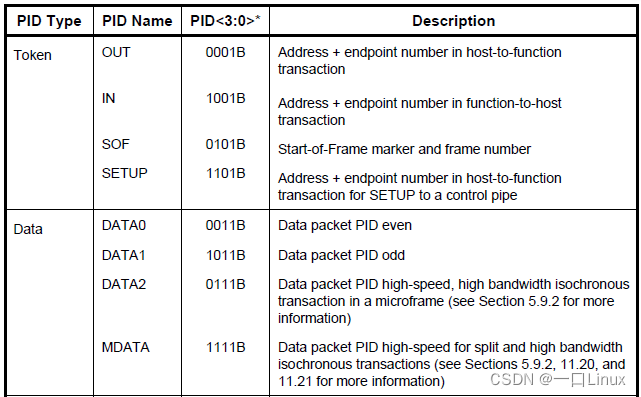

1.2 Token Packets
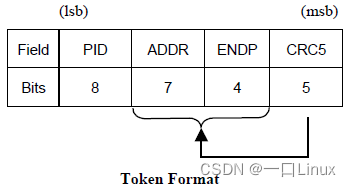
This format applies to IN、OUT、SETUP、PING.
PID Data transmission direction
IN Device->Host
OUT Host->Device
SETUP Host->Device
PING Device->Host
1.3 Start-of-Frame(SOF) Packets
SOF By Host Send to Device.
- about full-speed Bus , every other 1.00 ms ±0.0005 ms Send it once ;
- about high-speed Bus , every other 125 μs ±0.0625 μs Send it once ;
SOF The package composition is shown in the following figure
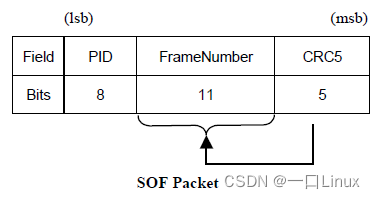
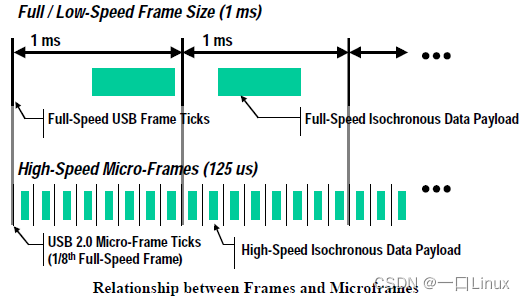
1.4 Data Packets

There are four types of packets :DATA0, DATA1, DATA2,and MDATA, And by the PID To distinguish between .DATA0 and DATA1 It is defined to support data switching and synchronization (data toggle synchronization).
1.5 Handshake Packets
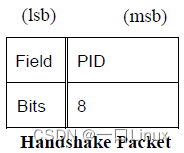
- ACK: about IN Business , It will be host issue ; about OUT、SETUP and PING Business , It will be device issue .
- NAK: In the data phase , about IN Business , It will be device issue ; In the handshake phase , about OUT and PING Business , It will also be device issue ;host Never send NAK package .
2. Business (Transaction)
stay USB The process of receiving or sending data information on a is called transaction processing (Transaction) namely :The delivery of service to an endpoint. A transaction consists of a system packet form , By which packet form , It depends on the specific transaction . It may consist of the following packages :
- One token packet
- Optional data pcket
- Optional handshake packet
- Optional special packet
2.1 Input (IN) Transaction processing
Enter transaction : Express USB The host is from a... On the bus USB The process of a device receiving a packet .
- 【 normal 】 Input transactions for

- 【 The device is busy 】 Input transactions at

- 【 Device error 】 Input transactions at

2.2. Output (OUT) Transaction processing
Output transactions : Express USB The host outputs a packet to a point on the bus USB The process of equipment receiving .
- 【 normal 】 Output transactions of

- 【 Device busy 】 Output transactions of

- 【 Device error 】 Output transactions of

2.3 Set up (SETUP) Transaction processing
- 【 normal 】 Set transactions

- 【 Device busy 】 Set transactions

- 【 Device error 】 Set transactions

3. USB Transfer type
stay USB In transit , Defined 4 Types of transmission :
- Control transmission (Control Transfer)
- Interrupt transmission (Interrupt Transfer)
- Bulk transfer (Bulk Transfer)
- Synchronous transmission (Isochronous)
3.1 Control transmission (Control Transfer)
The control transmission is controlled by 2~3 There are three stages :
- The establishment phase (Setup)
- Data phase ( No data control, no such stage )(DATA)
- State phase (Status)
Each stage consists of one or more ( Data phase ) The transaction transmission consists of (Transaction).
The control data is controlled by USB The system software is used to configure the equipment ( When enumerating ), Other driver software can be used control transfer To achieve specific functions , Data transmission cannot be lost .
3.1.1 The establishment phase
Host from USB The device obtains configuration information , And set the configuration value of the device . The data exchange in the establishment phase includes SETUP Token packet 、 Next to it DATA0 Data packets and ACK Handshake packet . Its function is to execute a setting ( Vague concept ) Data exchange of , And define the content of this control transmission ( namely : stay Data Stage in IN or OUT Of data Number of packages , And sending direction , stay Setup Stage Has been set ).
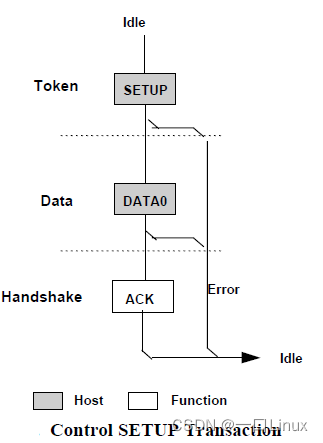
3.1.2 Data phase
According to the direction of data transmission in the data stage , Control transmission can be divided into 3 Types :
- Control reading ( Read USB The descriptor )
- Control write ( To configure USB equipment )
- No data control
Data transmission phase : It is used to transmit data between the host and the device .
- Control reading
It is to read data from the device to the host , Read data USB Device descriptor . The process is shown in the figure below 【Control Read】 Shown . For every data packet , First , The host will send a IN Token packet , It means to read data in . then , The device passes data through DATA1/DATA0 Data packets are sent back to the host . Last , The host will respond in the following way : When the data has been received correctly , The host sends ACK Token packet ; When the host is busy , issue NAK Handshake packet ; When an error occurs , The host sends out STALL Handshake packet .
- Control write
It is to transfer data from the host to the device , The data transmitted is right USB Configuration information of the device , The process is shown in the following figure 【Control Wirte】 Shown . For every data packet , The host will send a OUT Token packet , It means that the data should be sent out . Then , The host passes data through DATA1/DATA0 Data packets are passed to the device . Last , The equipment will respond in the following ways : When the data has been received correctly , The equipment sends ACK Token packet ; When the device is busy , Equipment issue NAK Handshake packet ; When an error occurs , Equipment issue STALL Handshake packet .
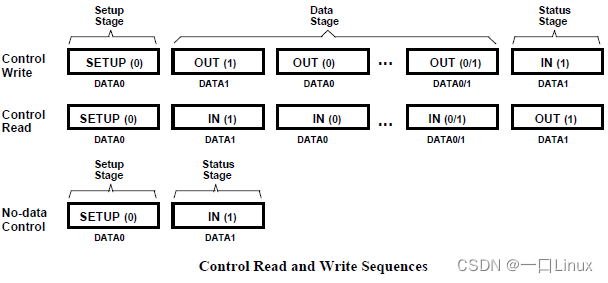
3.1.3 State phase
State phase : Used to indicate that the whole transmission process has completely ended .
The direction of state phase transmission must be opposite to that of data phase , It turns out to be IN Token packet , This stage should be OUT Token packet ; conversely , Turned out to be OUT Token packet , This stage should be IN Token packet .
about 【 Control reading 】 for , The host will send OUT Token packet , Then follow 0 Of length DATA1 Packet . And then , The equipment will also make corresponding actions , send ACK Handshake packet 、NAK Handshake packets or STALL Handshake packet .
Relatively speaking, for 【 Control write 】 transmission , The host will send IN Token packet , Then, the device sends out the 0 Of length DATA1 Packet , The host makes corresponding actions again : send ACK Handshake packet 、NAK Handshake packets or STALL Handshake packet .
3.2 Bulk transfer (Bulk Transfer)
Used to transmit large amounts of data , Request that the transmission cannot fail , But there is no requirement for time , Suitable for printers 、 Storage devices, etc .
Batch transmission is a reliable transmission , A handshake packet is required to indicate the result of the transmission . If the amount of data is large , Multiple batch transaction transfers will be used to complete the transmission of all data , Of packets during transmission PID according to DATA0-DATA1-DATA0-… Flip... In a way , To ensure the synchronization between the sender and the receiver .
USB Allow continuous 3 Less than transmission errors , The transfer will be retried , If successful, reset the error count , Otherwise, the counter is accumulated . After more than three times ,HOST It is considered that the endpoint function is wrong (STALL), Abandon the transmission task of the endpoint .
One batch transmission (Transfer) from 1 One to more batch transaction transfers (Transaction) form .
Flip synchronization : The sending end follows DATA0-DATA1-DATA0-… Send packets in order , Only a successful transaction transfer will result in PID Flip , That is to say, the sender only receives ACK And then flip PID, Send next packet , Otherwise, this transaction transfer will be retried . Again , If it is found at the receiving end that the received packets are not flipped in this order , For example, two consecutive DATA0, Then the receiving end considers the second DATA0 It was the previous one DATA0 The retransmission .
It is implemented at the hardware level “ Error detection ” and “ Retransmission ” To make sure that host And device Between “ Accurate ” Transmit data more efficiently , Can rely on transmission . It consists of three kinds of bags ( namely IN Business or OUT Business ):
- token
- data
- handshake
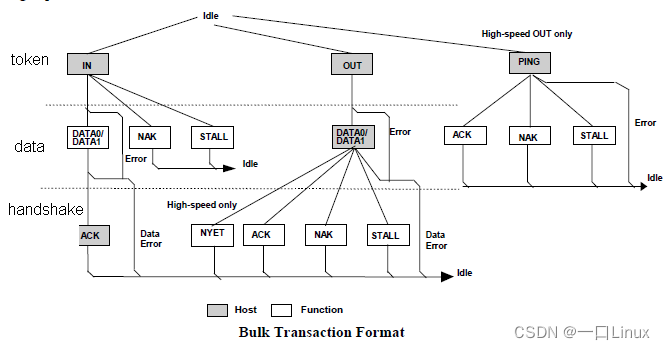
- For IN Token ( namely :IN Transaction)
- ACK: Express host Receive data correctly
- NAK: Indicates that the device is temporarily unable to return or receive data ( Such as : The device is busy )
- STALL: Indicates that the device will stop forever , need host Software intervention ( Such as : Device error )
- For OUT Token ( namely :OUT Transaction)
If the received packet is incorrect , Such as :CRC error ,Device Don't send any handshake package
- ACK: Device The packet has been received correctly , And notify Host You can send the next packet in sequence
- NAK: Device The packet has been received correctly , And notify Host Retransmission data , because Device Temporary situation ( Such as buffer full )
- STALL: instructions Device endpoint Has stopped , And notify Host No retransmission
- Bulk Read write sequence
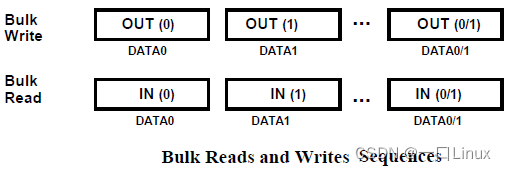
That is, by a system IN Business or OUT Transaction composition .
3.3 Interrupt transmission (Interrupt Transfer)
Interrupt transmission by IN or OUT Transaction composition .
Interrupt transmission is not supported in the process PING outside , Others are the same as batch transmission . The only difference between them is that the endpoint of transaction transmission is different 、 The maximum package length supported is different 、 Different priorities and other things that are transparent to users .
When the host schedules an interrupt transmission task , The interrupt transmission will be initiated according to the query interval specified in the corresponding interrupt endpoint descriptor . Interrupt transmission has a higher priority , Second only to synchronous transmission .
Similarly, interrupt transmission also adopts PID Flip mechanism to ensure data synchronization at the receiving and transmitting ends . The following figure shows the flow chart of interrupt transmission .
Interrupt transmission mode is always used to query the equipment , To determine whether there is data to be transmitted . Therefore, the direction of interrupt transmission is always from USB Device to host .

DATA0 or DATA1 Contains interrupt information , Instead of interrupting data .
3.4 Synchronous transmission (Isochronous Transfer)
- It consists of two packages :
- token
- data
Synchronous transmission is not supported “handshake” and “ Retransmission capability ”, So it is unreliable transmission .
Synchronous transmission is an unreliable transmission , So it doesn't have a handshake bag , Nor does it support PID Flip . When the host schedules a transaction transfer , Synchronous transmission has the highest priority .
Synchronous transmission applies when you must arrive at a fixed rate or at a specified time , Can tolerate occasional wrong data . Real time transmission is generally used for wheat Kefeng 、 horn 、UVC Camera Other equipment . Real time transmission only requires two packet stages, token and data , No handshake bag , Therefore, the data will not be retransmitted when it is wrong .
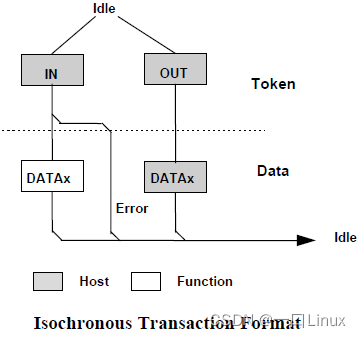
边栏推荐
- 第3章业务功能开发(用户登录)
- 【可信计算】第十次课:TPM密码资源管理(二)
- Please insert the disk into "U disk (H)" & unable to access the disk structure is damaged and cannot be read
- 第1章CRM核心业务介绍
- Functions and usage of serachview
- Functions and usage of ratingbar
- alertDialog創建对话框
- YARN Capacity Scheduler容量调度器(超详细解读)
- Functions and usage of imageswitch
- L1-023 输出GPLT(Lua)
猜你喜欢
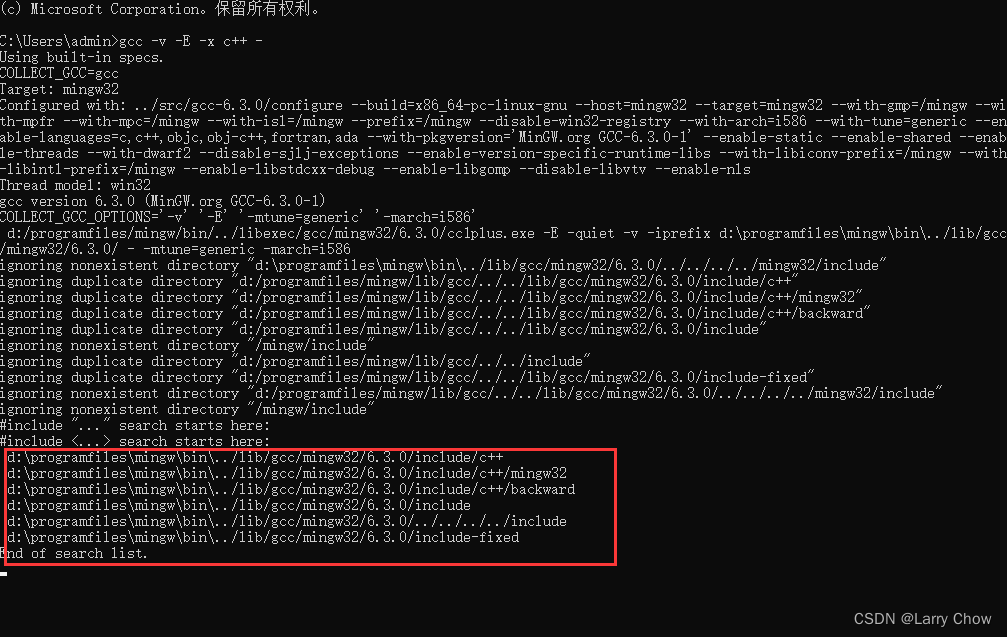
Vscode three configuration files about C language

Functions and usage of imageswitch

企业即时通讯软件是什么?它有哪些优势呢?

Deep learning machine learning various data sets summary address

【网络攻防原理与技术】第6章:特洛伊木马
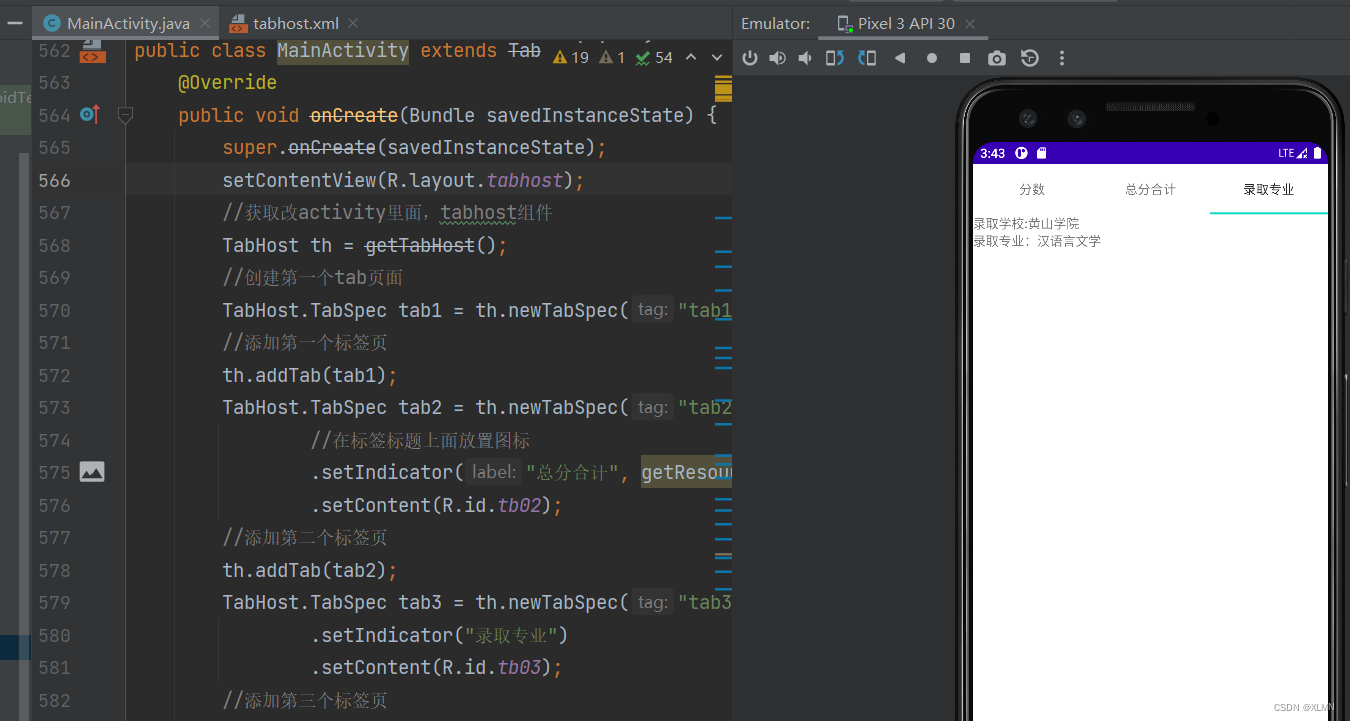
Functions and usage of tabhost tab

YARN Capacity Scheduler容量调度器(超详细解读)
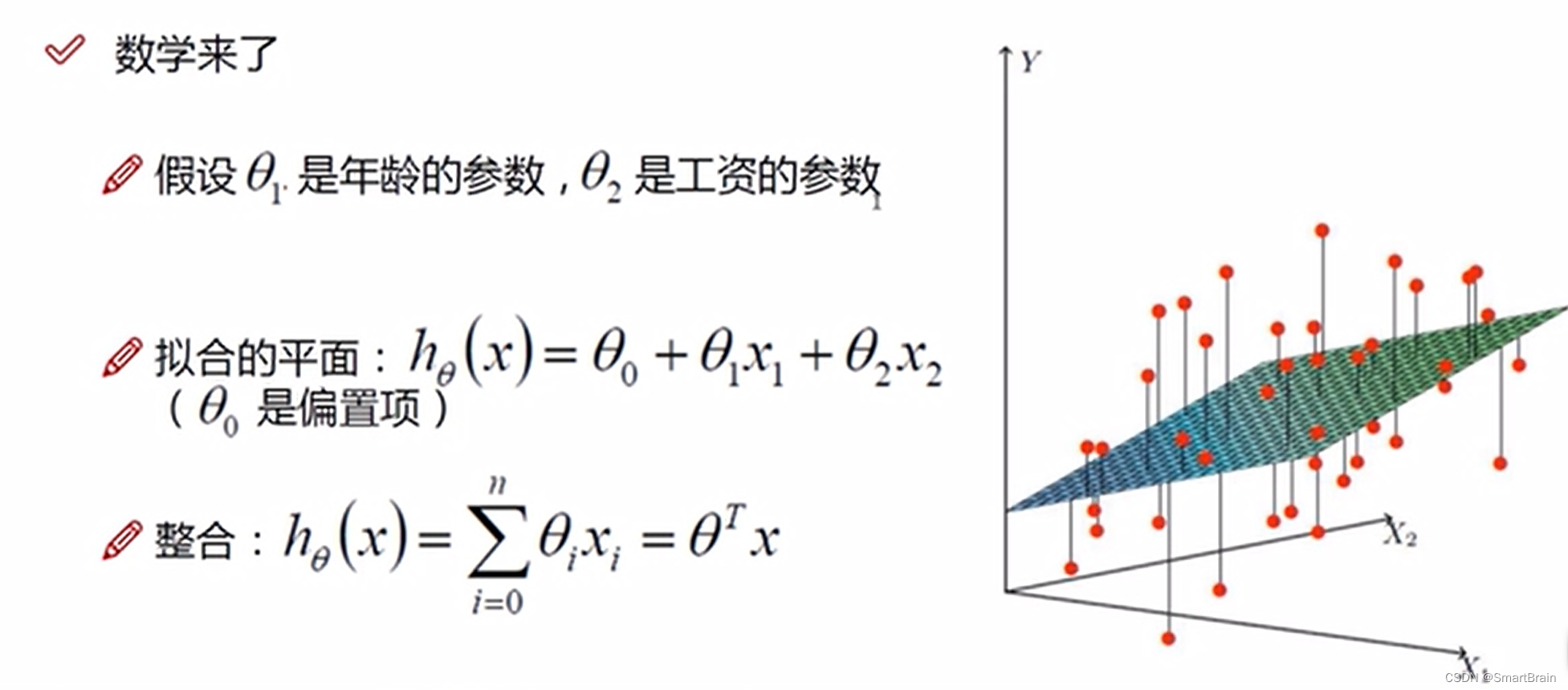
深入浅出【机器学习之线性回归】

Ansible 学习总结(9)—— Ansible 循环、条件判断、触发器、处理失败等任务控制使用总结

Face recognition attendance system based on Baidu flying plasma platform (easydl)
随机推荐
Functions and usage of viewswitch
What is agile testing
LeetCode1051(C#)
责任链模式 - Unity
Yarn capacity scheduler (ultra detailed interpretation)
swiper左右切换滑块插件
本周小贴士#136:无序容器
Based on pytorch, we use CNN to classify our own data sets
第3章业务功能开发(实现记住账号密码)
Audio Device Strategy 音频设备输出、输入 选择 基于7.0 代码
Import requirements in batches during Yolo training Txt
textSwitch文本切换器的功能和用法
Deep learning - make your own dataset
使用OneDNS完美解决办公网络优化问题
【深度学习】3分钟入门
简单的loading动画
【分布式理论】(二)分布式存储
【重新理解通信模型】Reactor 模式在 Redis 和 Kafka 中的应用
MRS离线数据分析:通过Flink作业处理OBS数据
Audio device strategy audio device output and input selection is based on 7.0 code